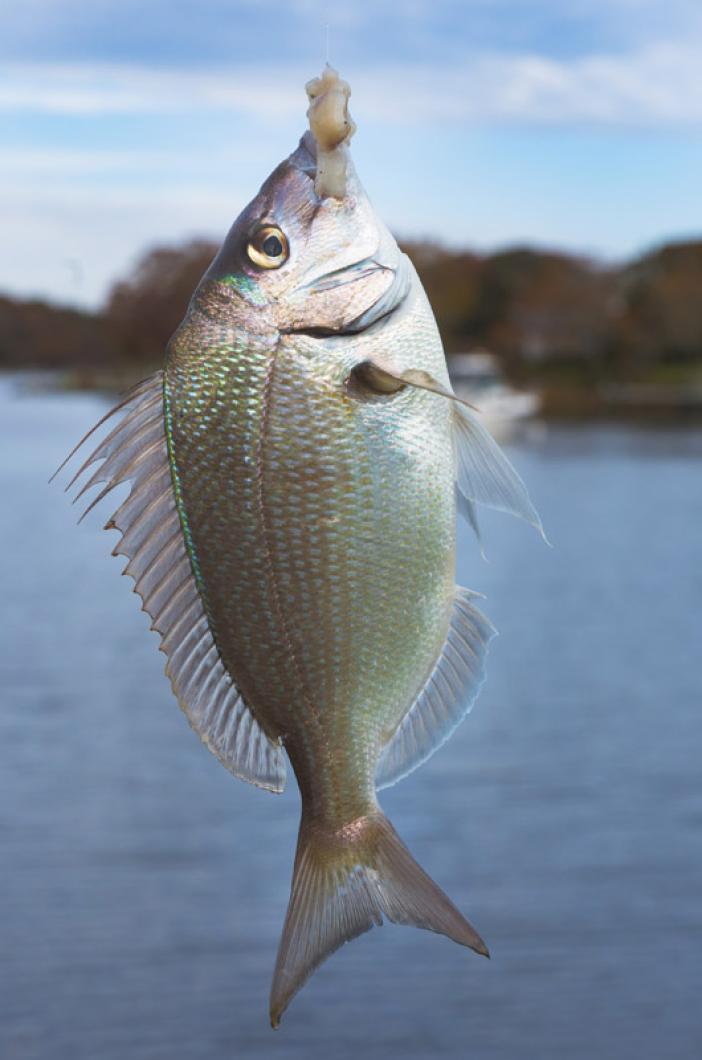From the August 5, 1949 edition of the Vineyard Gazette:
“Scaupaug” is what the Wampanoags called this fish in the long ago. He is a chunky-bodied, silvery fish, with a rosy tinge along the back, at times, a gleam of greenish-blue iridescence along his spikey fins and sometimes, depending on the bottom where he has fed, distinct dark stripes up and down his sides, and a dark, muddy stain on his underside. His weight is anything from three pounds down, but averaging less than a pound as he commonly runs in these waters.
The scaupaug, known as scup locally, and paugie in waters farther west, is a fish of tradition. Generations have said that the scup appears coincident with the blooming of the wild pear or shadbush. The colonials said that the Lord sent the scup in order that the poor people might not starve, and this requires some explanation.
The herring ran before the scup in spring; the cod also ran in spring and fall. But the colonials, hard-pressed to earn a livelihood, were forced to sell such fish as had a marketable value, especially for export, and there was a steady demand for the herring and cod. But the scup could be salted and eaten fresh as well, and because of this fact, plus the lack of demand for it in the markets of the time, there were many coastal people who appeared to have fed on the scup in order to sell their entire take of the other varieties.
Fifty years ago, before the otter trawl and large power-driven vessels made winter fishing common in northern waters, the scup disappeared from the fresh fish markets for the greater part of the year. Not until the fish-traps were set in the spring did it reappear, always when the wild pear bloomed, as the fishermen said.
At that time there was always a scramble for them in certain sections, and the price of the first run was something to marvel over. Twenty-three or four cents a pound was often received by the fisherman for the early catch of scup and half that was a common price for a time thereafter. Shrewd fishermen, who prepared for this period in advance, would keep their scup in “pockets” or yards, or nets, shipping just what the market could absorb each week and thereby contriving to prevent a glut of scup as long as possible.
This was not too long, because within a few weeks’ time the hand-line fisherman, and they were legion then, would begin to land scup in two and four-barrel lots, alive, from their fish-wells, and the price would drop on the trapped fish, and eventually on the live ones also.
But long, long ago, the scup fell into disfavor. Since then, with the propaganda which educated the American public to eat only fish fillets, the scup has largely gone begging. A scup can be fileted, but only by a slow and painful process, and when the word painful is employed, it may be taken literally as well as figuratively. Every spine and bone in the fish appears to be aimed squarely at the operator, and unless he is well-skilled, he is apt to be bleeding and in pain in short order.
Yet a scup is not a bony fish to eat, because the greater number of the spines and bones are easily removed when it is cleaned. However, the Powers that Be, behind the national fish business, turned thumbs down on the scup, and that was that. It did not freeze well, when boned, and that was another point against it, and so time passed with fewer and fewer people eating the fish and only a few people attempting to make any real business of catching them.
But today, out of a clear sky, something has happened. Last week the price of scup at the cap-log was the highest in years at this season. Locally, a retailer said that summer people are asking for scup, and offered an attractive price for them. Perhaps the scup is returning to favor, and if so, this is something over which to celebrate.
For the scup is easily caught and may be found almost anywhere during the warm months. Naturally the fish run largest in the deepest water, but fine pan fish can be taken near the shores. They will bite on almost anything, shellfish baits, squid, and some of the small winkles. With a little practice a person can learn to clean them without suffering injury, the only thing to remember is to clean them while they are still fresh and wet. A sun-dried scup is hard to scale and scales do not go well in any sort of dish.
Old timers always favored a scup for boiling, with plenty of butter, pepper and salt, and it is true that few fish lend themselves to this method of cooking as pleasantly as this fish. But there is a school which prefers its scup fried, when it is delicate and fine flavored also.
The marvel is its apparent return to favor. Little boats drifted with the tide last week from half-way up Vineyard Sound almost to Edgartown, and all were catching scup. Just what may come from this sudden demand for scup is hard to say. The realization that it is, indeed, a delicious food-fish, may well restore its former popularity.
Compiled by Hilary Wallcox
library@mvgazette.com







Comments
Comment policy »